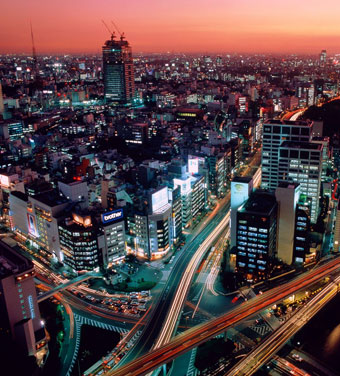Japan
Country statistics

Land area: 144,689 sq miles (374,744 sq km)
Total area: 145,883 sq miles (377,835 sq km)
Population (2010 est.): 126,804,433 (growth rate: -0.24%); birth rate: 7.4/1000; infant mortality rate: 2.8/1000; life expectancy: 82.1; density per sq km: 339
Capital City: Tokyo
Monetary unit: Yen
Languages: Japanese
Ethnicity/race: Japanese 99%, other 1% (mostly Korean)
Religions: Shintoist and Buddhist 84%, other 16% (including Christian 0.7%)
Country introduction

Japan, a country of islands in East Asia, extends along the Pacific coast. It lies to the east of the Sea of Japan, China, North Korea, South Korea and Russia, stretching from the Sea of Okhotsk in the north to the East China Sea and Taiwan in the south. The characters that make up Japan's name mean "sun-origin", which is why Japan is sometimes referred to as the "Land of the Rising Sun".
Japan is the 18th most densely populated country in the world. About 73% of the country is mountainous, and unsuitable for agricultural, industrial, or residential use, due to the generally steep elevations, climate, and risk of landslides caused by earthquakes, soft ground, and heavy rain. This has resulted in an extremely high population density in the habitable zones that are mainly located in coastal areas.
It is location on the Pacific Ring of Fire, at the juncture of three tectonic plates, gives Japan frequent low-intensity earth tremors and occasional volcanic activity. Destructive earthquakes, often resulting in tsunamis, occur several times each century. The most recent major quakes include the 2004 Chuetsu earthquake and the Great Hanshin earthquake of 1995.
Hot springs are numerous, and have been developed as resorts.
The culture

Japanese culture has evolved greatly over the years, from the country's original Jomon culture to its contemporary hybrid culture, which combines a number of influences from Asia, Europe, and America.
Historically, China and Korea have been the most influential, starting with the development of the Yayoi culture from around 300 BC and culminating with the introduction of rice farming, ceremonial burial, pottery, painting, writing, poetry, etiquette, the Chinese writing system, and Mahayana Buddhism by the 7th century AD.
From the mid-19th century onward, Western influence prevailed, with American influence becoming especially predominant following the end of World War II. This influence is apparent in Japan's contemporary popular culture, which combines Asian, European, and, 1950-onward, American influences. Both within the country and abroad, its people have achieved international acclaim in fashion, films, literature, television, video games, and music.
Notable contributions of modern Japan to the rest of the world come from the technology sector, such as that of cell phones, camcorders, and mp3 players. This category also includes some of the highest caliber video games and game consoles. The unique art and thematic styles present in animation (anime) and graphic novels (manga) have also presented a unique addition to the world's entertainment field. Japanese culture has attracted many devotees in Europe and North America as well.
Attractions & landmarks

Popular destinations in Japan are well endowed with beautiful landscapes, amazing science museums, state of the art sports venues, enchanting amusement parks and many more.
Among the popular Japan destinations, Tokyo is most favored by tourists. The Imperial Palace, the Sensoji Temple, Keji shrine and many other temples and monasteries offer a splendid architectural view to the tourists. The modern attractions like the many amusement parks, museums on science and technology and sky scrappers hold the awe of the visitors. Tokyo features many internationally famous forms of modern architecture including the Tokyo International Forum, Asahi Beer Hall, Mode Gakuen Cocoon Tower, NTT Docomo Yoyogi Building and the Rainbow Bridge. Tokyo also features two distinctive towers: the Tokyo Tower and the new Tokyo Skytree which is the tallest tower in Japan and the second tallest structure in the world.
In the old capital Kyoto, the historic forts built by the Samurais can be visited. The beautiful laid out gardens and temples there, attract thousands of tourists every day. The technology city of Yokohama and Osaka have many museums dedicated to futuristic technology. The giant atomic dome and the adjacent museum in Hiroshima has been erected to remind everyone of the need for peace in the progress of human civilization. Kobe with its enchanting attractions adds to the popular tourist destinations.
The giant sport arenas and entertainment complexes at various parts of Japan are among the popular attractions for the tourists. The Giza quarters in Kobe and Kyoto are always found to be crowded by tourists. Japan is the leader of technology and it is best visible in the cinema halls of Japan. The multiplexes are simply beyond imagination. In the cities of Tokyo and Yokohama, there are thousands of malls exclusively selling electronic and computer items.
In terms of natural landmarks, Mt.Fuji is undoubtedly Japan's main attraction. It is the highest mountain in the country, at 3,776 m (12,388 ft) high, and more than 200,000 people climb to the top every year.